Wieliczka Salt Mine
Kopalnia Soli "Wieliczka"
Useful Information
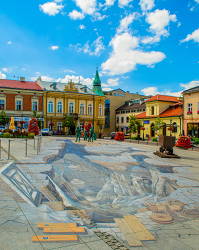
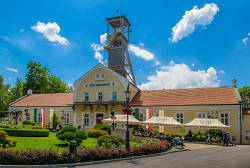
| Location: |
In Wieliczka. 14 km south-east of Cracow. (49.983486, 20.055747) |
| Open: |
It is necessary to book tickets online, open times can be found in online booking system. Post-pandemic Aftermath Post-pandemic AftermathTourist Route: All year daily 8-18. Graduation Tower: All year daily 10-18. Closed 01-JAN, Easter, 01-NOV, 24-DEC, 25-DEC. [2022] |
| Fee: |
It is necessary to book tickets online, ticket prices can be found in online booking system. Post-pandemic Aftermath Post-pandemic AftermathTourist Route: Adults PLN 119, Children (5-15) PLN 99, Children (0-4) free, Students (-26) PLN 109, Seniors (65+) PLN 109, Disabled PLN 109, Family (2+2) PLN 337. Graduation Tower: Adults PLN 9, Children (5-15) PLN 6, Children (0-4) free, Students (-26) PLN 6, Seniors (65+) PLN 6, Disabled PLN 6, Family (2+2) PLN 24. [2022] |
| Classification: |
 Salt Mine Salt Mine
 Halotherapy Halotherapy
|
| Light: |
 Incandescent Incandescent
|
| Dimension: | 7.5 million m², L=320,000 m, D=315 m, T=14 °C. |
| Guided tours: |
D=3 h, L=3,500 m, VR=135 m, St=800, Max=35. V=1.000.000/a[2010]. 






|
| Photography: | allowed without flash |
| Accessibility: | no |
| Bibliography: |
Janusz Podlecki (2001):
Wieliczka - A Royal Salt Mine,
Publishing House Karpaty, ISBN-10: 8388553054, ISBN-13: 978-8388553059, Hardcover, Language: English.
 at Amazon.com at Amazon.com
Janusz Podlecki (2004): Wieliczka Historic Salt Mine, Karpaty Publishing House, ISBN-10: 8388553410, ISBN-13: 978-8388553417, Hardcover  at Amazon.com at Amazon.com
Eva March Tappan, ed. (1914): The World’s Story: A History of the World in Story, Song and Art, Vol. VI: Russia, Austria-Hungary, The Balkan States, and Turkey. Houghton Mifflin, Boston. pp. 370-377.  The Salt Mines of Wieliczka, 1850, Modern History Sourcebook by Bayard Taylor The Salt Mines of Wieliczka, 1850, Modern History Sourcebook by Bayard Taylor
|
| Address: |
Tourism Organisation Department, Tel: +48-12-278-73-02, Tel: +48-12-278-73-66.
E-mail: Daniłowicz Shaft, ul. Daniłowicza 10, 32-020 Wieliczka. Regis Shaft, pl. Kościuszki 9, 32-020 Wieliczka. |
| As far as we know this information was accurate when it was published (see years in brackets), but may have changed since then. Please check rates and details directly with the companies in question if you need more recent info. |
|
History
| 1119 | first time mentioned as Magnum Sol or Wielika Sol. |
| 1290 | start of salt mining according to legend. |
| 13?? | 60 saxon miners came to Wieliczka and built new salt mines. |
| 1368 | the statutes of King Casimir the Great ruled the rights and privileges of the miners. |
| 1826-1846 | salt water from the mine used in a spa. |
| 1897-1927 | Nikolaus Kopernikus skulptured in salt. |
| 1950 | parts of the mine improved to make a museum and show mine. |
| 1958 | spa revived by Professor Mieczysław Skulimowski. |
| 1968 | end of salt mining, salt was still extracted by solubilisation with water. |
| 1978 | inscribed on the UNESCO World Heritage List. |
| 1988 | salt production ends. |
| 1992 | an inundation of water threatened an important part of the tourist route. |
| 1996 | salt mining stopped, salt deposits almost completely mined. Opened as show mine. |
Geology
The salt deposits in the northern foreland of the Carpathians was deposited during the Badenium (~15 Ma). This was a result of the Carpathian orogeny, which caused the subsidence in front of the moutains. The evaporites are found all along the mountains, but only around Cracow they contain rock salt. In the other parts there is only gypsum. In the Wieliczka layer five evaporation cycles were found. The evaporites are covered by marls and siltstones, which are water-resistant and protect the salt from being deissolved by groundwater.
In Wieliczka the salt was broken into huge block, up to 150 m big, which were dubbed salt brekzia. It is interpreted as the result of tectonic movements at the active rim of a basin. Salt is found in 9 levels between 64 and 327 m deep.
Description
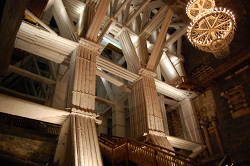
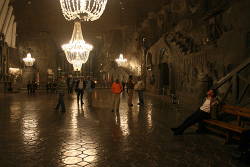
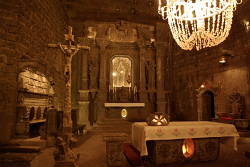
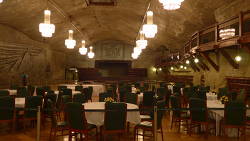
The Royal salt mine at Wieliczka has not really a name, it is a salt mine and it is located at Wieliczka. Sometimes it is called Royal Mine, but that’s also a description, not a name. As a result we have read half a dozen different versions of the name on different pages on the web, so its actually best if you just search for the name Wieliczka. Its unique and most results will be for this tourist mine. Common versions of the name are Kopalnia Soli "Wieliczka" (Salt Mine "Wieliczka") and Wieliczka Solny Skarb (Wieliczka Salt Treasure).
This site is actually not a show mine, in other words the topic of the mine is not the mining of the salt, this is only mentioned on the tour. The main topic are the artworks and sculptures which were made of salt by the miners. The mine is like a vast underground city with churches, sculpture galleries, dance halls, and artworks, and also rooms for leisure activities. Rather close to the entrance the chapel of Saint Antonius is located. The room was once covered with sculptures made of salt. But the moisture in the air from outside destroyed the figures, they started to dissolve or melt. Today they look like modern art, or maybe prehistoric sculptures. Other churches which are deeper in the mine, like the Cathedral, are well-preserved. Here even the chandeliers are made of salt. The walls are covered with sculptures of Saints and scenes from the bible. Sometimes the room is used for weddings.
The water of the springs in this area always contained salt, which was used at least for 5,000 years. The brine was cooked on fire until the whole water was gone and the salt remained in the pot. But in the 13th century the mining for salt started. How this happened is told in an old legend about princess Kinga, who was later beatified and is the patron Saint of the miners around Krakow.
The Hungarian princess Kinga was to marry the sovereign of Krakow. She wanted to bring a wealthy gift for her fiancé. As the people in Poland had everything except salt, she asked her father for a salt mine as adowry, which he provided. She threw one of her rings into a salt mine of her father and travelled to Poland. Near Krakow, in Wieliczka she told the people to dig a deep pit. The miners found salt, and enclosed in the first piece of salt they mined was the ring of Kinga.
It is the oldest working mine which is open for tourists in Europe. Salt was mined here as long as 700 years ago and today the mine consists of nine levels going down to a depth of 327 m. There are 2,040 chambers connected by 200 km of passages. Today it is a superlative tourist destination with more than a million visitors per year. This is actually a site you should visit on a rainy weekday in November, not on a sunny Sunday in Juli. On the other hand it is actually no problem to get a tour in a foreign language, last time we checked they offered tours in seven language every day, common languages like english hourly. But they always had a knack for complicated open hours and fees, there were complicated rules for the open hours and different fees depending on month and weekday. We once listed this, but it is actually futile. Especially as Covid-19 has changed anything, for some time the restrictions required prebooking and since then they have an online ticket system. Check the day you want to visit and book your ticket online.
In 1978 the mine was included in the UNESCO World Heritage List, it has the number 32, so it was among the very first sites which were listed. At that time the list was almost unknown, but the fame of Wieliczka and the list have increased substantially since then. During the Cold War the possibility to visit was limited, but after 1990 the number of international visitors boosted. In 1992 there was an inundation of water from some old workings which threatened not only an important part of the tourist route containing many statues and carvings, but also endangered the town itself. A successful cleanup operation was carried out and the mine was once again reopened to the public. In 1994 by the Decree of the President of the Republic of Poland, it was declared a Monument of History of the Polish Nation.
The regular tour into the mine is not difficult, but it is rather long, it takes between two and three hours. The mine is entered down the Paderewski Shaft and after 3.5 km walk underground the visitors return to the surface through Regis Schaft. Also, the tour has 800 steps, so you should be fit enough to walk this distance. With 14 °C the mine is rather warm, but a light jacket is advisable. There are also special tours but they are offered only at special times, some were discontinued during the pandemic. The Miners’ Route emphasizes on the mining history and technology, and less on the artworks. The Graduation Tower is on the surface, and it is only a short 30 minutes self-guided visit. This tower was used to evaporate water while it flows down the tower, the result is a brine with a higher amount of salt, so in the end the amount of energy required to get the salt is reduced.
The building beneath the salt mine contains a mining and salt museum which is named Muzeum Żup Krakowskich Wieliczka (Krakow Saltworks Museum Wieliczka). Most visitors think it is a part of the salt mine, but actually it is a museum operated by the Ministery of Culture, so we have a separate page for this.
- See also
 Subterranean World Heritage List
Subterranean World Heritage List Search DuckDuckGo for "Wieliczka Salt Mine"
Search DuckDuckGo for "Wieliczka Salt Mine" Google Earth Placemark
Google Earth Placemark Wieliczka Salt Mine - Wikipedia (visited: 01-JUN-2022)
Wieliczka Salt Mine - Wikipedia (visited: 01-JUN-2022) Kopalnia Soli „Wieliczka”, official website
Kopalnia Soli „Wieliczka”, official website  (visited: 01-JUN-2022)
(visited: 01-JUN-2022) The “Wieliczka” Salt Mine, official website (visited: 01-JUN-2022)
The “Wieliczka” Salt Mine, official website (visited: 01-JUN-2022) Wieliczka Salt Mine, The World Heritage List - souterrains (visited: 01-JUN-2022)
Wieliczka Salt Mine, The World Heritage List - souterrains (visited: 01-JUN-2022) Air Pollutant Intrusion into the Wieliczka Salt Mine by Lynn Garry Salmon (visited: 01-JUN-2022)
Air Pollutant Intrusion into the Wieliczka Salt Mine by Lynn Garry Salmon (visited: 01-JUN-2022)
 Index
Index Topics
Topics Hierarchical
Hierarchical Countries
Countries Maps
Maps